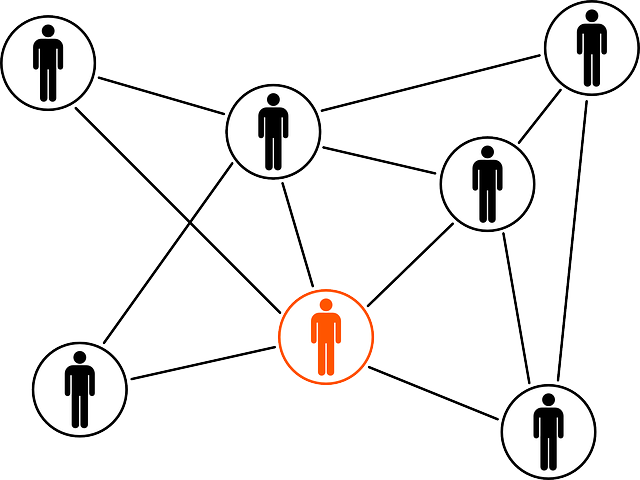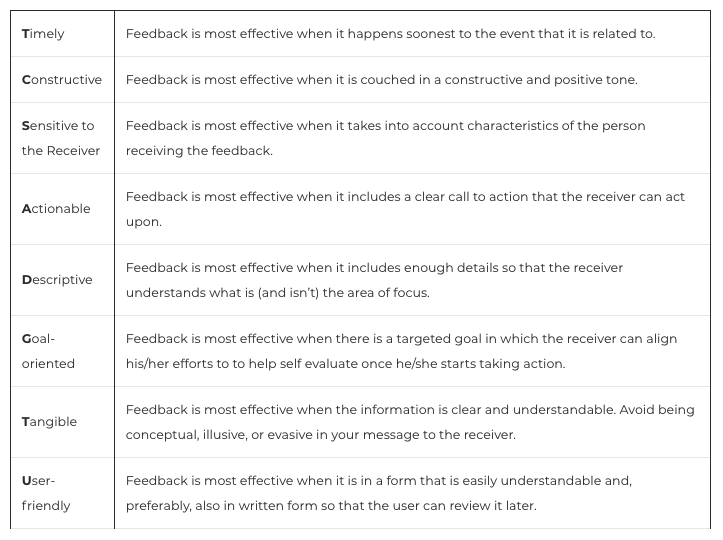Regardless of the time of year, your staff will benefit from positive, relevant input to help them be more successful. One way of doing that is by adding the use of feedforward to your managerial strategies. Providing feedforward can be especially helpful if you have staff that need more confidence, haven’t shown great improvement with current feedback, or may associate their understanding of feedback more with criticism. Let’s first review good feedback before touching on feedforward so you can more easily see the difference.
Effective Feedback

Feedback focuses on the outcome of past performance. There are eight factors that go in to making feedback effective for employee growth and satisfaction. Though you don’t have to include all eight in each feedback you give, the more you include will enhance the ability of the receiver to accept the feedback and implement the recommendations. Below is a chart showing the factor along with a brief description. One silly sentence to help you remember these eight factors is by using the mnemonic device: Tigers Create Schedules After Donkeys Give Ticklish Unicorns.
| Timely | Feedback is most effective when it happens soonest to the event that it is related to. |
| Constructive | Feedback is most effective when it is couched in a constructive and positive tone. |
| Sensitive to the Receiver | Feedback is most effective when it takes into account characteristics of the person receiving the feedback. |
| Actionable | Feedback is most effective when it includes a clear call to action that the receiver can act upon. |
| Descriptive | Feedback is most effective when it includes enough details so that the receiver understands what is (and isn’t) the area of focus. |
| Goal-oriented | Feedback is most effective when there is a targeted goal in which the receiver can align his/her efforts to to help self evaluate once he/she starts taking action. |
| Tangible | Feedback is most effective when the information is clear and understandable. Avoid being conceptual, illusive, or evasive in your message to the receiver. |
| User-friendly | Feedback is most effective when it is in a form that is easily understandable and, preferably, also in written form so that the user can review it later. |
What Is Feedforward?

Unlike feedback, which focuses on past outcomes, feedforward focuses on future inputs. The concept of feedforward, developed by executive coaching guru Marshall Goldsmith, seeks to help managers and the like overcome limiting beliefs and behaviors to achieve greater success. The feedforward strategy is helpful for just-in-time moments as well as for performance reviews. The three basics of feedforward include the following:
Reinforce what is working. Start the feedforward session highlighting what is working well. Identify and share about an area of the employee’s work that is achieving, if not surpassing, expectations. Sometimes these areas may not receive any attention and the employee may question if these successful areas are even noticed or appreciated.
Coach to the future (don’t criticize the past). Like a great sports coach, be solution oriented. Share and brainstorm solutions of how to get to the desired goals. Of course, this assumes the employee understands the goal(s) whether they are provided for him or whether he has identified them for himself. If the goal you are coaching for is unclear, you may need to highlight the goal and have a side conversation with the employee so he not only understands it, but why the goal is important (and achievable).
Be task focused. When the information is task focused, employees are more likely to feel they have control. Many times employees have received feedback that is not task oriented but more about personality or the person. You may have experienced that yourself and felt more attacked than supported.
Additional Resources

Here are some additional resources that cover a variety of areas, not just ones for education. Reviewing these resources will help round out your understanding of feedforward well beyond what this post has provided. You will find that this topic is actually very rich with information and relevant to your area of work whether you are a CEO, the head of a curriculum department, manage the business department, or the principal on a campus.
- Want to Give Feedback? Rather Try Feedforward! (six-page PDF)
- Why Feedforward Works Better Than Feedback in Managing Performance
- Making a Case for “Feedforward” vs. Performance Reviews
- Ten Surefire Reasons to Try Feedforward!

If you aren’t sure how to jump in to providing feedforward, then refer to the PDF (linked above). Use the partner activity to allow your staff to give feedforward to each other. This can be helpful for them to hear from each other (assuming they understand the other person’s role) and allow them to experience it in a non-threatening way prior to you giving feedforward from a supervisor role.
So, if you find yourself fed up with feedback, then try providing feedforward for the win. I think your staff and you will find it a refreshing difference. And it might just be the difference that helps your team get to the next level of performance, the level you want, but they don’t believe is possible. Who knows, you might be the boss whose feedforward turns your so-so employees into stellar employees!

